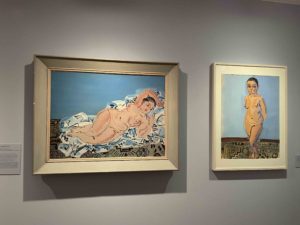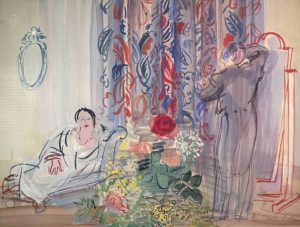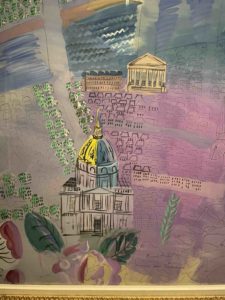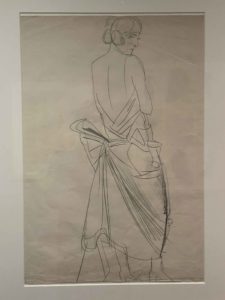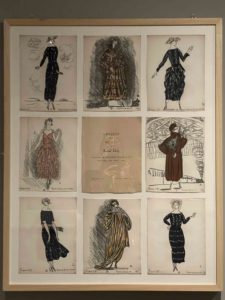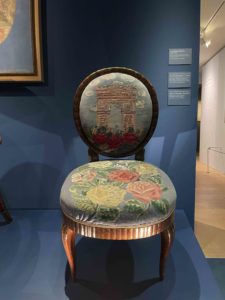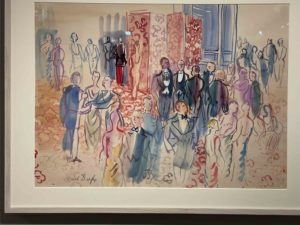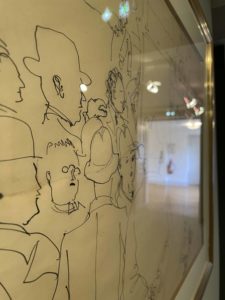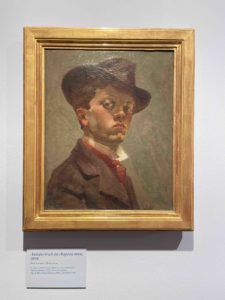
R.Dufy (21 yrs) auto-portrait in a soft hat, 1898, oil on canvas.
“Mes yeux sont faits pour effacer ce qui est laid.”
« My eyes were made to erase all that is ugly »
Raoul Dufy
From Normandy to Montmartre, Paris.
I am a big fan of Dufy and as soon as the museums in Paris reopened, I went with a friend to see the exhibition of his work, at the small and charming Montmartre museum. Dufy is best known and recognised by the public at large, for his later work that features fresh colours and assured line drawing, which I particularly love, but of course his career was so much more. He was perhaps one of the first commercial artist/designers.
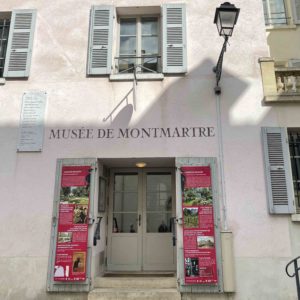
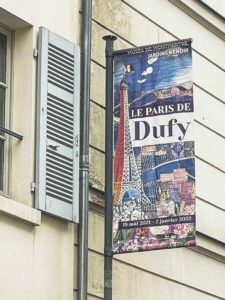
The exhibition follows in the footsteps of the young artist from Normandy who discovered the capital at the beginning of the 20th century and the community of artists that lived in Montmartre, situated on a hill that overlooks Paris from the north.
Raoul Dufy (1877 –1953) was a French Fauvist painter. He developed a colourful, decorative style that became fashionable for designs of ceramics and textile, as well as decorative schemes for public buildings. He was also a draftsman, printmaker, book illustrator, scenic designer, a designer of furniture and a planner of public spaces.
He was born into a large family in Le Havre, in Normandy. He left school at the age of fourteen to work in a coffee-importing company, but in 1895, when he was 18, he started taking evening classes in art at at the town École des Beaux-Arts. The classes were taught by Charles Lhuillier, who forty years earlier had been a student of the famous French portrait painter Ingres and it was there that Dufy met Raimond Lecourt and Othon Friesz, with whom he later shared a studio in Montmartre and to whom he remained a lifelong friend.
In 1900, after a year of military service, Dufy won a scholarship to the École Nationale supérieure des Beaux-Arts in Paris. His first exhibition took place in 1901. In 1902 he was introduced to Berthe Weill, a French art dealer who played a vital role in the creation of the market for twentieth-century art, and he showed his work in her gallery. Then he exhibited again in 1903 at the Salon des Indépendants.
Inspiration At The Paris Art Salon.
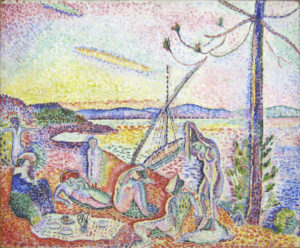
Henri Matisse’s “Luxe, calme et volupté”,
(Luxury, Calm and Pleasure) was painted in the summer of 1904.
Henri Matisse‘s Luxe, Calme et Volupté, which Dufy saw at the Salon des Indépendants in 1905, was a revelation to the young artist, and it directed his interests towards Fauvism. Les Fauves (the wild beasts) emphasised bright colour and bold contours in their work. Dufy’s painting reflected this aesthetic until about 1909 when contact with the work of Paul Cézanne led him to adopt a somewhat subtler technique. However, it was not until 1920 that Dufy developed his own distinctive approach.
It involved skeletal structures, arranged with foreshortened perspective, and the use of thin washes of colour applied quickly, in a manner that came to be known as stenographic. Dufy’s cheerful oils and watercolours depict events of the time period, including yachting scenes, sparkling views of the French Riviera, chic parties, and musical events. The optimistic, fashionably decorative, and illustrative nature of much of his work has meant that his output has been less highly valued critically than the works of artists who have addressed a wider range of social concerns.Dufy’s unique interpretation of Fauvism, which he adopted after 1905, was to marry the movement’s avant-garde formal principles with a decorative aesthetic. His use of spontaneous, expressive lines and intense, non-naturalistic colour, can be seen in his many pleasure-filled images of regattas, horse racing, and outdoor leisure activities in France.
Dufy The Designer.
In addition to his work as a painter, water colourist, and printmaker, a major component of Dufy’s artistic output was his work as a textile designer. Beginning in 1909, Dufy created colourful block-printed silk and cotton fabrics featuring the dynamic geometries and exotic motifs of Art Deco. Dufy’s designs were used by the most famous haute couture designers of the time, and have been hailed as some of the artist’s most enduring and popular artistic achievements.
Dufy worked on a number of large-scale public art commissions during his career. With their combination of modern and allegorical subjects rendered in exuberant outlines and hyper-intense colours, these monumental works represent the artist’s successful modernist take on the classic mural tradition. Dufy also acquired a reputation as an illustrator and as a commercial artist. He painted murals for public buildings; he also produced a huge number of tapestries and ceramic designs.
By 1950, his hands were struck with rheumatoid arthritis and his ability to paint diminished, as he had to fasten the brush to his hand. In April he went to Boston to undergo an experimental treatment with cortisone and corticotropin, based on the work of Philip S. Hench. It proved successful, and some of his next works were dedicated to the doctors and researchers in the United States. In 1952 he received the grand prize for painting in the 26th Venice Biennale.
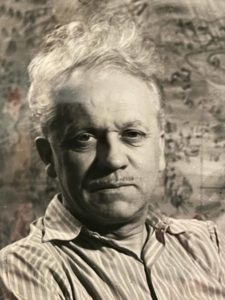
Dufy died at Forcalquier, in the south east of France, on 23 March 1953, of intestinal bleeding, probably a result of his continuous treatment. He was buried near Matisse in the Cimiez Monastery Cemetery, a suburb of the city of Nice.
After the exhibition we wandered around the almost empty streets and stopped for lunch here at Le Consulat, which after the lockdowns and closures, all seemed very strange.
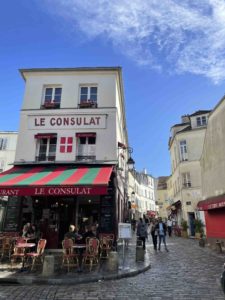
Thank you for visiting,
Henrie
![]() ____________________________________________________________________________________________________________________________________________________
____________________________________________________________________________________________________________________________________________________
Exhibition Catalogue Eng/Fr:
Available in France here, €19,95.
Available in the UK here, £15.91.
Available in the USA here, $25,65.


